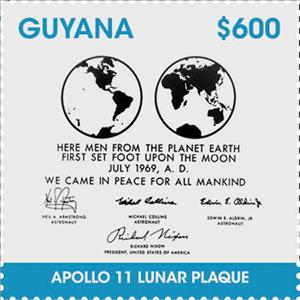Stamp: Apollo 11 Lunar Plaque (Guyana 2018)
Apollo 11 Lunar Plaque (Guyana 2018)
20 November (Guyana ) within release 50th Anniversary of the First Moon Landing goes into circulation Stamp Apollo 11 Lunar Plaque face value 600 Guyanese dollar
| Stamp Apollo 11 Lunar Plaque in catalogues | |
|---|---|
| Michel: | Mi: GY 9558 |
| Stamp Number: | Sn: GY 4592a |
| Colnect codes: | Col: GY 2018.11.20-8a |
Stamp is square format.
Stamp from souvenir sheet Footnoted in: Stanley Gibbons Perforation: '13¾' for Stamp NumberAlso in the issue 50th Anniversary of the First Moon Landing:
- Souvenir Sheet - 50th Anniversary of the First Moonlanding face value 1,200;
- Mini Sheet - 50th Anniversary of the First Moonlanding face value 1,650;
- Stamp - Apollo 11 Lunar Plaque face value 600;
- Stamp - Apollo 11 Mission Patch Showing Eagle face value 600;
- Stamp - Astronaut Buzz Aldrin face value 200;
- Stamp - Astronaut Buzz Aldrin Descending Ladder from Eagle onto Moo… face value 300;
- Stamp - Astronaut Buzz Aldrin Walking on Moon face value 350;
- Stamp - The Eagle in Space face value 250;
- Stamp - The Earth from Space, 1969 face value 150;
- Stamp - The Moon from Space, 1969 face value 400;
Stamp Apollo 11 Lunar Plaque it reflects the thematic directions:
A globe is a spherical model of Earth, of some other celestial body, or of the celestial sphere. Globes serve purposes similar to maps, but, unlike maps, they do not distort the surface that they portray except to scale it down. A model globe of Earth is called a terrestrial globe. A model globe of the celestial sphere is called a celestial globe
The Moon is Earth's only natural satellite. It orbits at an average distance of 384,400 km (238,900 mi), about 30 times the diameter of Earth. Tidal forces between Earth and the Moon have over time synchronized the Moon's orbital period (lunar month) with its rotation period (lunar day) at 29.5 Earth days, causing the same side of the Moon to always face Earth. The Moon's gravitational pull – and to a lesser extent, the Sun's – are the main drivers of Earth's tides.
Outer space (or simply space) is the expanse that exists beyond Earth's atmosphere and between celestial bodies. It contains ultra-low levels of particle densities, constituting a near-perfect vacuum of predominantly hydrogen and helium plasma, permeated by electromagnetic radiation, cosmic rays, neutrinos, magnetic fields and dust. The baseline temperature of outer space, as set by the background radiation from the Big Bang, is 2.7 kelvins (−270 °C; −455 °F)



